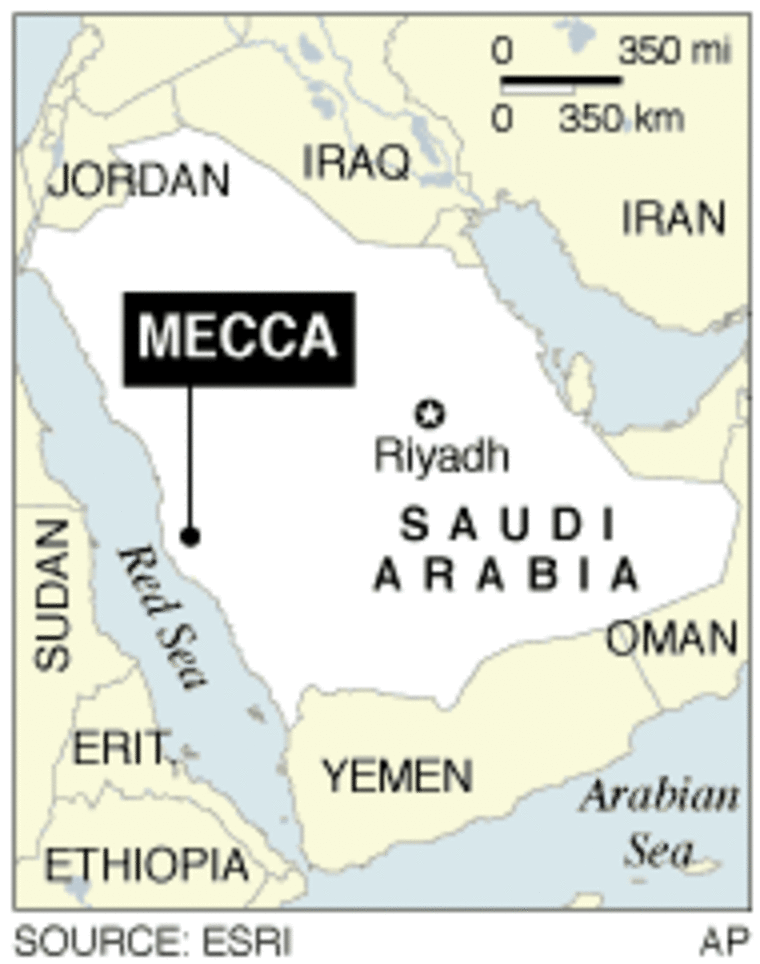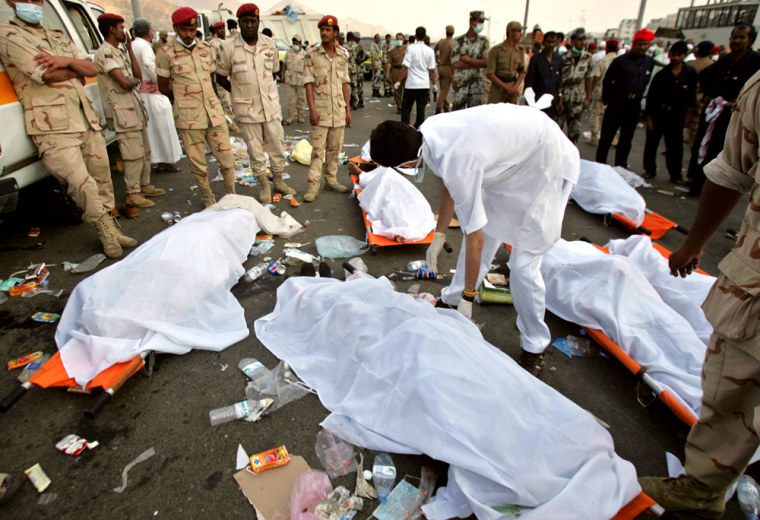Thousands of Muslim pilgrims rushing to complete a symbolic stoning ritual during the hajj tripped over luggage Thursday, causing a crush in which up to 400 people were killed despite Saudi attempts to prevent stampedes that have plagued the annual event.
The stampede occurred as tens of thousands of pilgrims headed toward al-Jamarat, a series of three pillars representing the devil that the faithful pelt with stones to purge themselves of sin.
Late Thursday, Saudi officials estimated that 400 people were killed. More than 1,000 people were injured, said Dr. Abbasi with the Saudi Red Crescent.
Footage from the scene showed lines of bodies laid out on stretchers on the pavement and covered with sheets. Ahmed Mustafa, an Egyptian pilgrim, said he saw bodies taken away in refrigerator trucks.
An Egyptian pilgrim, Suad Abu Hamada, heard screaming and “saw people jumping over each other.”
“The bodies were piled up. I couldn’t count them, they were too many,” she said.
Stampedes occurred in past years
The site is a notorious bottleneck for the massive crowds that attend the annual hajj pilgrimage and has seen deadly stampedes in the past, including one in 1990 that killed 1,426 people and another in February 2004 that killed 244. Seven of the past 17 yearly pilgrimages have seen deadly incidents at al-Jamarat.
The latest crush came despite Saudi attempts to ease the flow of traffic around al-Jamarat. This year’s hajj was marred by the Jan. 5 collapse of a building being used as a pilgrims’ hotel that killed 76 people in Mecca.
The stampede happened as pilgrims were rushing to complete the last of three days of the stoning ritual before sunset, said Interior Ministry spokesman Maj. Gen. Mansour al-Turki. Some of the pilgrims began tripping over dropped baggage, causing a large pileup, he said.

Many pilgrims carry their personal items with them as they move between the various stages of the hajj.
Earlier, al-Turki said some baggage spilled from moving buses at one entrance to al-Jamarat, causing pilgrims to trip and pile up. However, no vehicles were allowed in the area where the stampede occurred.
Al-Turki said 345 people were killed. State-run Saudi television Al-Ekhbariyah reported that most of the victims were from South Asia. The Health Ministry said 289 people were injured.
The pillars are located on a large pedestrian bridge, the width of an eight-lane highway over the desert plain of Mina outside the holy city of Mecca. Four ramps lead up the bridge to give
pilgrims access to the site, and the stampede occurred at the base of one ramp.
Victims sent to neighboring city hospitals
Mina General Hospital, a small facility several hundred yards from the site, was filled with injured, and some victims were sent to hospitals in Mecca and Riyadh, said Ismail Abdul-Zaher, a doctor at the hospital.
Ambulances and police cars streamed into the area, and security forces tried to move pilgrims away from part of the site, though thousands continued with the ritual.
The stampede took place despite Saudi efforts to improve traffic at the site, where all 2.5 million pilgrims participating in the annual hajj move from pillar to pillar to throw their stones, then exit.
Saudi authorities replaced the small round pillars with short walls to allow more people to throw their stones without jostling for position. The walls extend down through the bridge and protrude underneath, so pilgrims below can also carry out the stoning without going above.
Attempts to prevent stampede
Officials also recently widened the bridge, built extra ramps and increased the time pilgrims can carry out the rite — which on the second and final days traditionally takes place from midday until sunset.
Shiite Muslim clerics have issued religious edicts allowing pilgrims to start the ritual in the morning, and many Shiites from Iraq, Iran, Bahrain, Lebanon and Pakistan took advantage to go early in the day.
“This is much better. We are now done with the stoning before the crowd gets larger,” an Iranian pilgrim, Azghar Meshadi, said hours before the stampede.
But Saudi Arabia’s Sunni Muslim clerics, who follow the fundamentalist Wahhabi interpretation of Islam, encouraged pilgrims to stick to the midday rule.
Troops patrolling area
About 60,000 Saudi troops have patrolled the Mina plain since the stoning ritual began Tuesday, intending to ensure a smooth flow of pilgrims. Helicopters fly overhead, and authorities monitor the pilgrims from a control room through closed-circuit television.
But often the police appeared overwhelmed, unable to manage the crowds — a task complicated by peddlers selling food and souvenirs to the pilgrims and jamming up traffic. In theory, two of the ramps leading up to the pillars are for entry and two for exit, but pilgrims often ignore the rules and go up and down wherever they wish.
Signs giving directions to pilgrims — many of whom are at the site for the first time — are few.
The stoning ritual is one of the last events of the hajj pilgrimage to Islam’s holiest sites, which able-bodied Muslims with the financial means are required by their faith to do at least once.
Many pilgrims had already finished the stoning ritual Thursday and had gone back to Mecca to carry out a farewell circuit around the Kaaba, the black stone cube that Muslims face when they do their daily prayers.
